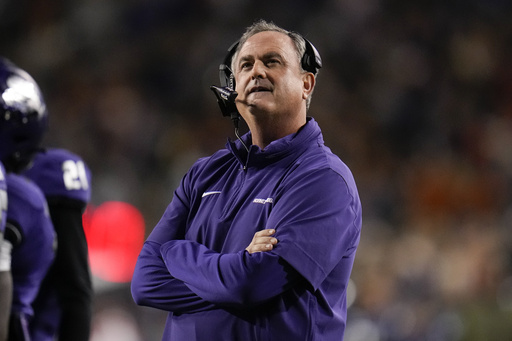SCOTTDALE, Ariz. (AP) — Before the realigned Big 12 — sans Oklahoma and Texas —even kicks off, the expanded College Football Playoff’s new revenue structure has created a perception that the conference is no longer the equal of the Big Ten and Southeastern Conference.
Instead of a Power Five, college football now has a “Big Two,” with the expanded SEC, now home to the Sooners and Longhorns, and Big Ten at the top of the pack.
Big 12 commissioner Brett Yormark’s job is to push back against the narrative that bigger bank accounts automatically means better football teams.
“As I’ve said before, I’m betting on the Big 12,” Yormark said Wednesday after wrapping up two days of meetings with the conference’s athletic directors and football and basketball coaches.
The Big 12 becomes a 16-team conference this upcoming season with the additions of former Pac-12 schools Arizona, Arizona State, Colorado and Utah.
The CFP is expanding, too, from four teams to 12 this season, with five spots reserved for conference champions. That all but ensures the winners of the Big Ten, SEC, Big 12 and Atlantic Coast Conference will be in the field.
The demise of the Pac-12 prompted a change in the 12-team format before it even went into effect from six conference champions being guaranteed a spot in the field to five.
How those seven at-large spots will be divvied up among what is now a Power Four in college football figures to be much debated, but the Big Ten and SEC have already established something of a pecking order.
“You’re kind of either labeled as one of the haves, one of the have-nots,” TCU coach Sonny Dykes said.
When the new contracts kick in for the expanded CFP in 2026, the Big Ten and SEC are guaranteed to share nearly 60% of the revenue. The Big 12 and ACC will split up about 30%. In the original four-team playoff agreements, the Power Five received equal revenue shares.
“When you look at the first 10 years of the CFP, we didn’t perform probably as well as we would have liked. That’s OK. History might not repeat itself.”
Yormark said he “certainly wasn’t happy” with where the CFP the revenue distribution landed.
“I guess you could say in some respects I was satisfied. It was fine, but certainly not happy about it,” he said.
Yormark said he pushed for a look-in on the new CFP deal after the 2027 season, where adjustments could be made to the CFP financial agreement.
When the new deal begins in 2026, the CFP could expand again to 14 teams. Yormark said he likes the idea of a bigger field, but said he would like to see at least this season play out before any decision is made on further expansion.
He also said he and the conference’s basketball coaches “in theory” support a modest expansion of the NCAA men’s basketball tournament.
Talk of the Big Ten and SEC getting more automatic bids than the other leagues and guaranteed first-round byes went by the wayside for now, but the message has been sent: The Big 12 and ACC are no longer true peers.
How that plays out come selection Sunday remains to be seen.
“I think that you always want your program to be judged by the merits, not by the geography,” Dykes said.
The ACC already is feeling slighted after Florida State, a true blue blood with three national championships on its resume, was snubbed by the CFP selection committee last year after star quarterback Jordan Travis was injured.
For the non-Florida State, Clemson and Miami schools in the ACC, the conference already being viewed as a less-than is disconcerting because they are already are at an perception disadvantage.
“Sometimes I think anytime a non-traditional power in a power conference has success, it’s easier to discredit the league than to credit the team,” Wake Forest coach Dave Clawson said.
For the Big 12, losing their flagship schools, the only two with recent national championship pedigree, creates an opportunity for the current members but also makes for a different evaluation process.
Texas and Oklahoma, “logo schools” as Dykes calls them, were barometers in the Big 12. TCU sweeping the Longhorns and Sooners on the way to a CFP appearance in 2022 helped validate the Horned Frogs as a legitimate playoff contender, even though Dykes will remind you Kansas State was the second-best team in the conference.
TCU is one of two teams in the Big 12’s new lineup to have made the four-team playoff, along with Cincinnati, which made the field out of the American Athletic Conference in 2021.
TCU, Colorado and BYU are Big 12 members that can claim national championships, though CU’s was the most recent, coming in 1990. Even without traditional super powers, the Big 12 still has a chance to be a strong and deep conference.
“We’re going to continue to build football to the core of what we do, and I’m excited about our future,” Yormark said.
___
Follow Ralph D. Russo at https://twitter.com/ralphDrussoAP and listen at http://www.appodcasts.com
___
AP college football: https://apnews.com/hub/college-football
This website uses cookies so that we can provide you with the best user experience possible. Cookie information is stored in your browser and performs functions such as recognising you when you return to our website and helping our team to understand which sections of the website you find most interesting and useful.
